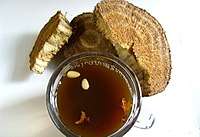Arrowroot tea
Arrowroot tea,[1] also called kudzu tea,[2] is a traditional East Asian tea made from East Asian arrowroot,[3] a type of kudzu.
| Arrowroot tea | |
|---|---|
 | |
| Type | Herbal tea |
| Other names |
|
| Origin | East Asia |
| Quick description | Tea made from East Asian arrowroot |
| Temperature | 100 °C (212 °F) |
| Chinese name | |||||||||||
|---|---|---|---|---|---|---|---|---|---|---|---|
| Chinese | 葛根茶 | ||||||||||
| |||||||||||
| Korean name | |
| Hangul | 칡차 |
|---|---|
| Hanja | -茶 |
| Revised Romanization | chikcha |
| McCune–Reischauer | ch'ikch'a |
| IPA | [tɕʰik̚.tɕʰa] |
| Hangul | 갈근차 |
| Hanja | 葛根茶 |
| Revised Romanization | galgeun-cha |
| McCune–Reischauer | kalgŭn-ch'a |
| IPA | [kal.ɡɯn.tɕʰa] |
| Hangul | 갈분차 |
| Hanja | 葛粉茶 |
| Revised Romanization | galbun-cha |
| McCune–Reischauer | kalbun-ch'a |
| IPA | [kal.bun.tɕʰa] |
Names
Arrowroot tea is called gegen-cha (葛根茶) in Chinese, kuzuyu (葛湯; くずゆ) in Japanese, and chikcha (칡차), galgeun-cha (갈근차; 葛根茶), and galbun-cha (갈분차; 葛粉茶) in Korean.
Preparation
Japan
Kuzuyu (葛湯) is a sweet Japanese beverage that is made by adding kudzu flour to hot water. It has a thick, honey-like texture, and a pale, translucent appearance.[4] It is served in a mug or tea bowl. During the winter, Kuzuyu is traditionally served for dessert as a hot drink.
In Japanese, Kuzu (葛) is the word for "kudzu". It is also translated as "arrowroot",[5] although kudzu and arrowroot are distinct plants. Yu (湯) means "hot water".[6][7] In English, the name of the drink is sometimes translated as kudzu starch gruel[8][7][9] or arrowroot tea.
In order to make Kuzuyu, Kudzu flour is added to hot water and stirred until thick. Kudzu flour, or Kuzuko (葛粉), is a powder that is made from the dried root of the kudzu plant. Kudzu flour can also be used in East Asian sauces and soups, as it is a powerful thickening agent.[10] When added to hot water, it quickly alters the water's texture. Though lacking fragrance and taste in its powder form, the arrowroot takes on a unique sweet flavor when dissolved in the hot water.
Korea
Chikcha (칡차; "arrowroot tea") can be made with either sliced East Asian arrowroot or the starch powder made from the root.[1][11] Chick (칡) is the native Korean name of the plant, while cha (차; 茶) means "tea". Chikcha can also refer to the tea made from arrowroot flower.[12] Chikcha made from powdered arrowroot is also called galbun-cha (갈분차; 葛粉茶). Gal (갈; 葛) is the Sino-Korean name for the plant, and bun (분; 粉) is the translation of "powder".[13] Conversely, chikcha made by boiling the dried roots is called galgeun-cha (갈근차; 葛根茶), with geun (근; 根) meaning "root".[14]
The roots are harvested from late autumn to early spring. They are then washed, peeled, and sun-dried.[12] To make tea, 15–20 g (0.53–0.71 oz) of fresh roots are simmered in 600 ml (21 imp fl oz; 20 US fl oz) of water over low heat, until the water is reduced by two thirds.[11][12] Jujubes can also be boiled with the shredded roots if desired.[11] The tea can be served hot or cold. While honey may be added to taste, sugar is not recommended.[12]
An alternative tea can be made by ground arrowroot. First, the roots are torn into thin shreds. They are then dried for twenty days in shade, followed by ten days in a hot ondol room, after which they are ground to a starch powder.[12] Tea is then made by mixing the starch powder with hot water.[13] The gruel-like tea that results can also be combined with sugar, milk, green tea, or cocoa.[11][13] Similar tea can also be made using starch powder from the scaly bulbs of Asian fawnlily.[13]
Chikcha made from the arrowroot flowers can also be prepared by infusing two dried flowers, preferably picked in August, in 600 ml (21 imp fl oz; 20 US fl oz) of hot water.[12]
See also
- Cinnamon tea
- Kelp tea
- Ginger tea
- Ginseng tea
- Traditional Korean tea
- Traditional Chinese tea
- Traditional Japanese tea
References
- Chun, Hui-jung (2004). Yoon, Ho-mi (ed.). Korean Food Guide 800. Seoul: The Korea Foundation. p. 208. ISBN 89-89782-10-4. Retrieved 25 August 2017 – via issuu.
- "Chikcha" 칡차. Korean-English Learners' Dictionary. National Institute of Korean Language. Retrieved 25 August 2017.
- English Names for Korean Native Plants (PDF). Pocheon: Korea National Arboretum. 2015. p. 596. ISBN 978-89-97450-98-5. Retrieved 25 August 2017 – via Korea Forest Service.
- The Essential Tea Guide, Teressa Hansch, 2013. 7ISBN 978-1482521115
- "Animelab.com: Japanese -> English Dictionary". Archived from the original on 2008-05-07. Retrieved 2008-06-27.
- Japanese Kanji - 湯 hot water トウ ゆ
- "KanjiDB: 湯 - hot water". Archived from the original on 2008-06-12. Retrieved 2008-06-27.
- "Animelab.com: Japanese -> English Dictionary". Archived from the original on 2008-05-07. Retrieved 2008-06-27.
- Kudzu
- Kudzu Root and Powder Profile
- National Institute of Agricultural Sciences (2010). 칡차. Jeontong Hyangto Eumsik Yongeo Sajeon 전통향토음식용어사전 (in Korean). Paju, Gyeonggi Province: Gyomoon Publishers. ISBN 9788936310608. Retrieved 25 August 2017 – via Naver.
- 정, 동효; 윤, 백현; 이, 영희, eds. (2012). 칡차의 건강기능 효과. Cha Saenghwal Munhwa Daejeon 차생활문화대전 (in Korean). Seoul: Hongikjae. ISBN 9788971433515. Retrieved 25 August 2017 – via Naver.
- "Galbun-cha" 갈분차. Doopedia (in Korean). Doosan Corporation. Retrieved 25 August 2017.
- "Galgeun-cha" 갈근차. Doopedia (in Korean). Doosan Corporation. Retrieved 25 August 2017.